There’s something almost magical about spotting those first silvery-soft catkins emerging on bare branches in late winter. When the world still looks gray and dormant, pussy willows whisper a promise: spring is coming.
These charming shrubs, with their touchably soft buds that feel remarkably like a kitten’s paw, have captivated gardeners for generations—and for good reason.
If you’ve ever run your fingers along those velvety catkins and thought, “I need these in my garden,” you’re in the right place. Growing pussy willows is surprisingly straightforward, even for beginners.
By the end of this guide, you’ll know exactly how to cultivate, care for, and enjoy these delightful early bloomers in your own landscape.
What Are Pussy Willows, Anyway?
Before we dig into the dirt, let’s get acquainted with what we’re actually talking about.
“Pussy willow” isn’t just one plant—it’s a common name applied to several species in the Salix (willow) genus, all characterized by those distinctive fuzzy catkins that emerge in early spring.
The three main species you’ll encounter
- American Pussy Willow (Salix discolor):
This North American native is the most commonly cultivated variety, growing 6-25 feet tall. It’s perfectly adapted to northern climates and is the best choice if you’re looking for a plant that supports local wildlife.
- Goat Willow (Salix caprea):
This European species, also called French pussy willow, can reach up to 20-30 feet. It has slightly broader leaves and larger catkins than its American cousin.
- Gray Willow (Salix cinerea):
Native to Europe and western Asia, this variety has earned a reputation for invasiveness in North America and should generally be avoided in home landscapes.
The Male-Female Dynamic
Here’s something fascinating that catches many gardeners by surprise: pussy willows are dioecious, meaning individual plants are either male or female.
The males produce those iconic pearl-gray, super-fuzzy catkins we all adore—the ones that look like tiny kitten toes. Female plants, on the other hand, produce smaller, greenish catkins that are far less showy.
When you’re shopping for pussy willows, always ask for a male plant if you want that classic pussy willow appearance. The good news? Most nurseries exclusively propagate and sell male plants since they’re what gardeners want.
Those fuzzy catkins aren’t just pretty—they’re actually flowers about to bloom. The soft coating of hairs acts as insulation, protecting the developing flowers from late winter cold.
As temperatures warm, the catkins gradually open to reveal masses of yellow stamens covered in pollen, providing one of the earliest food sources for hungry bees emerging from winter dormancy.
Why You Should Grow Pussy Willows
Beyond their undeniable charm, pussy willows offer several compelling benefits:
- Ecological Powerhouse:
These plants are keystone species in many regions, meaning they play an outsized role in supporting local ecosystems. They host caterpillars for hundreds of moth and butterfly species, including the viceroy and mourning cloak butterflies.
Early-season native bees, including some rare specialist species, depend on pussy willow pollen and nectar when little else is blooming.
- Problem-Solver for Wet Areas:
Got a soggy spot in your yard where most plants struggle? Pussy willows thrive there. They’re perfect for rain gardens, pond edges, or any low-lying area with poor drainage.
Their extensive root systems even help stabilize soil and prevent erosion along streams and slopes.
- Easy Propagation:
Want more plants? Simply stick a cutting in the ground. Seriously—that’s it. Pussy willows root so readily that a branch kept in a vase of water will sprout roots within weeks.
- Low-Maintenance Beauty:
Once established, these tough plants require minimal fussing. They tolerate cold winters brilliantly, handle humidity with ease, and bounce back from heavy pruning like champions.
- Seasonal Interest:
In late winter, the emerging catkins provide texture and form. In spring, they explode with yellow flowers. Summer brings lush green foliage, and some varieties offer attractive fall color before dropping their leaves.
Choosing the Right Location
Success with pussy willows starts with smart site selection. Think like the plant: in nature, you’d find pussy willows growing along stream banks, in wetlands, and in meadows with consistently moist soil.
While they’re adaptable, recreating those conditions in your garden will yield the best results.
Sunlight Requirements
Pussy willows perform best in full sun—aim for at least six hours of direct sunlight daily. The more sun they receive, the more catkins they’ll produce.
That said, they’ll tolerate partial shade, especially afternoon shade in hotter climates. In too much shade, expect fewer blooms and slower growth.
 Here are 36 Shade-Loving Herbs and Vegetables That Grow With Less Sunlight
Here are 36 Shade-Loving Herbs and Vegetables That Grow With Less Sunlight
Soil Preferences
Here’s where pussy willows differ from many garden plants: they don’t need well-drained soil.
In fact, they’re happiest in moist to wet soil that would cause root rot in less tolerant plants. They’ll grow in everything from clay to loam to sandy soil, as long as moisture is consistent.
The ideal pH range is slightly acidic to neutral (6.0-7.5), though they’re not particularly fussy about this. If you’re planting in average garden soil, enriching it with compost, leaf mold, or peat moss will give your pussy willow a good start.
The Root Issue: What to Avoid
Before you dig that hole, here’s a critical warning: pussy willow roots are aggressive and far-reaching. They can extend up to one and a half times the plant’s height, searching for water. This makes them fantastic for erosion control but problematic near infrastructure.
Never plant pussy willows within 15-20 feet of:
- Septic tank fields or drain fields
- Sewer lines or water pipes
- Building foundations
- Sidewalks, driveways, or patios
- Swimming pools
Those questing roots will find and infiltrate even small cracks in pipes, potentially causing expensive damage. Give them space to roam freely without causing mischief.
Planting Your Pussy Willow
Starting from Nursery Plants
While you can find pussy willows at some garden centers, availability can be spotty. When buying, look for plants with firm buds, vibrant green or brown stems (not gray or brittle), and a solid root ball.
Avoid any showing signs of stress—wilting, yellowing leaves, or dried-out soil.
The best planting time is fall, which gives roots a chance to establish before winter dormancy. Spring planting works too, but you’ll need to be more diligent about watering through the first summer.
Here’s how to plant:
- Choose your site carefully, keeping those invasive roots in mind.
- Dig a hole twice as wide as the root ball and about the same depth as the nursery container—no deeper, as you want the plant at the same level it was growing.
- Work a generous amount of compost or aged leaf mold into the excavated soil to boost fertility and moisture retention.
- Gently remove the plant from its container and tease out any circling roots.
- Set the plant in the hole, ensuring it’s straight, and backfill with your amended soil.
- Tamp down gently to eliminate air pockets, then water deeply and thoroughly.
- Apply 2-3 inches of organic mulch around the base, keeping it a few inches away from the trunk to prevent rot.
- Water daily for the first few weeks until the plant shows signs of active growth.
Propagating from Cuttings: The Easy Way
This is where pussy willows truly shine as beginner-friendly plants. You can propagate them with almost foolproof ease, either by rooting in water or planting directly in soil.
The Water Method
Take a 12-18 inch cutting from new growth (brown, flexible stems—not the older gray branches) in early spring, cutting at a 45-degree angle.
Remove any leaves from the bottom half of the cutting and place it in a container with several inches of water. Set the container in a cool, bright spot away from direct sunlight. Change the water every few days to keep it fresh.
Within 2-4 weeks, you’ll see roots forming. Once roots are 3-4 inches long, your cutting is ready to plant outdoors.
Here’s a fun bonus: the water your pussy willow cutting was rooting in contains natural rooting hormones (specifically indolebutyric acid) that can help other plants root too. Save that “willow water” and use it for propagating more challenging cuttings.
The Direct-to-Soil Method (Even Easier)
In early spring after frost danger passes, take the same 12-18 inch cutting from new growth. Dip the angled cut end in rooting hormone if you have it (though it’s not necessary).
Use a rod or stake to make a narrow hole in prepared soil, then insert the cutting so 4-6 inches are underground and at least two nodes (those little bumps on the stem) remain above ground.
Firm the soil around the cutting and water thoroughly. Keep the soil consistently moist—not waterlogged, but never completely dry.
The cutting should root and begin leafing out within 3-6 weeks. That’s literally it. No grow lights, no special equipment, no fussing. Nature does the work for you.
Caring for Established Pussy Willows
Once your pussy willow is in the ground and growing, maintenance is refreshingly simple. These plants are survivors, adapted to fluctuating wetland conditions, cold winters, and variable weather. Still, a little attention keeps them looking their best.
Watering Wisdom
Moisture is non-negotiable for pussy willows. In their ideal location (naturally wet or consistently moist soil), you might never need to water beyond the establishment period. But if you’ve planted in average garden soil or experience dry spells, regular watering is essential.
During the growing season (spring through fall), provide about 1-2 inches of water per week if rainfall doesn’t supply it. A drip irrigation system or soaker hose works beautifully for these water-loving plants.
The soil should feel consistently damp a few inches down—think of the moisture level of a wrung-out sponge.
In winter, established plants need less water but shouldn’t be left bone-dry. Occasional deep watering during dry winter spells keeps roots healthy.
Feeding Your Pussy Willow
Here’s delightful news: pussy willows aren’t heavy feeders. In rich, organically amended soil, they may never need fertilizer. These are tough, native (or naturalized) plants accustomed to growing in nutrient-variable wetland soils.
That said, once your plant is over a year old, you can give it an annual fall feeding if you’d like to encourage vigorous growth.
Use a balanced, slow-release fertilizer (10-10-10 or similar) at half the recommended strength, or simply top-dress with a 2-3 inch layer of compost or well-aged leaf mold.
Spread the fertilizer or compost from the trunk out to about 18 inches beyond the drip line (the outer edge of the branches), but don’t let it touch the trunk directly. If you’re applying synthetic fertilizer, use about half a pound per half-inch of trunk diameter.
 Learn about Banana Peel Fertilizer: Truth vs. Myths About This Popular Garden Hack
Learn about Banana Peel Fertilizer: Truth vs. Myths About This Popular Garden Hack
Mulching Matters
A good mulch layer serves multiple purposes: it helps retain soil moisture (critical for pussy willows), suppresses weeds, moderates soil temperature, and gradually breaks down to improve soil quality.
Apply 2-4 inches of organic mulch (shredded bark, wood chips, or aged leaf compost) in a ring around the plant, leaving a few inches of space immediately around the trunk for air circulation.
Refresh the mulch layer annually in spring or fall as it decomposes.
The Art of Pruning
Pruning is where you have real creative control over your pussy willow’s size and shape. Left unpruned, these fast-growing plants can reach 20-25 feet tall and become quite sprawling—a beautiful sight in a naturalized area, but potentially overwhelming in a small garden.
The good news? Pussy willows tolerate—even benefit from—aggressive pruning. The traditional approach involves annual pruning to keep plants compact and encourage straight stems filled with catkins.
When to Prune
The ideal time is late winter or very early spring, right after the catkins finish their show but before new leaves emerge. This timing allows you to enjoy the spring blooms while pruning encourages vigorous new growth that will bear next year’s catkins.
Flowers form on the previous year’s growth, so pruning at the wrong time (mid-summer, for example) means sacrificing next spring’s display.
How to Prune
Start by removing any dead, damaged, or diseased branches—this is housekeeping that can be done anytime. Cut these all the way back to healthy wood or to the ground.
Next, identify your oldest branches (these typically have grayish bark) and remove about one-third of them by cutting them to ground level. This rejuvenates the plant and prevents it from becoming a dense tangle of unproductive wood.
Locate the newest growth—flexible brown stems emerging lower on the plant. These vigorous shoots will produce abundant catkins next year. Cut the remaining older branches back to approximately the same height as these new shoots.
Make your cuts just above outward-facing nodes (those little bumps where buds form). Shoots that emerge from outward-facing nodes grow away from the center, creating an open, attractive form rather than a congested mess.
Remove any branches that cross and rub against each other, as these create wounds vulnerable to disease.
Coppicing for Florists
If you’re growing pussy willows primarily for cutting stems for arrangements, try coppicing—cutting the entire plant back to within 6-12 inches of the ground every year or two after blooming.
This sounds brutal but produces long, straight, unbranched stems absolutely covered in catkins. The plant regrows enthusiastically from the base and actually remains healthier with this treatment.
Renovation Pruning
Inherited an overgrown, neglected pussy willow? No problem. These tough plants can be cut back to ground level and will regrow from the base.
Do this in late winter, and by summer you’ll see multiple new shoots emerging. This drastic approach is also called rejuvenation pruning and essentially gives you a fresh start with the plant.
Seasonal Care Calendar
Late Winter (February-March):
- Watch for catkins emerging—the first exciting sign of the season
- Prune if you didn’t do so earlier
- Take cuttings for propagation if desired
- Apply spring mulch as the ground thaws
Spring (April-May):
- Enjoy the full catkin display, then watch them transform to golden yellow flowers
- Resume regular watering if rainfall is insufficient
- Watch for leaf emergence after flowering
- Apply compost top-dressing if soil needs enriching
Summer (June-August):
- Maintain consistent moisture, especially during hot, dry spells
- Watch for pests (aphids, caterpillars) and address if populations become problematic
- Enjoy the lush green foliage
- Mulch to conserve moisture
Fall (September-November):
- Appreciate fall color (some varieties turn yellow)
- Apply slow-release fertilizer if desired
- Take hardwood cuttings for propagation
- Continue watering until ground freezes
Winter (December-January):
- Plants are dormant and need minimal care
- Occasional watering during dry spells
- Remove heavy snow from branches to prevent breakage
- Plan your spring pruning strategy
Forcing Pussy Willows Indoors
One of life’s simple pleasures is bringing the promise of spring indoors while snow still covers the ground. Pussy willows are perfect for forcing—coaxing them to bloom weeks ahead of schedule.
The process couldn’t be simpler: In late winter (January through early March, depending on your climate), select branches that show swollen buds—those little bumps indicating catkins are forming inside.
Cut branches about 2 feet long at a 45-degree angle on a day when temperatures are above freezing if possible.
Bring the branches inside and place them in a vase filled with lukewarm water. While the ends are still submerged, cut another inch off the bottom of each stem—this second cut, done underwater, prevents air from entering and blocking water uptake.
Wrap the branches loosely in damp newspaper or cloth and place the vase in a cool (around 60-65°F), dark location for a day or two. This humidity trick jumpstarts the process.
After the resting period, remove the wrapping and move the vase to a cool spot in indirect light. Mist the branches daily.
Within 1-2 weeks, the catkins will push through their protective bud scales and fluff up into their full fuzzy glory. Eventually, you’ll see the yellow stamens emerge as the flowers mature.
- Preservation Tip:
If you want to keep pussy willow branches in their soft, fuzzy catkin stage for weeks or months, keep them dry. Don’t put them in water.
The catkins will retain their form and stay soft for several weeks when kept as a dried arrangement. If you do put them in water, they’ll continue developing, eventually producing roots—which is a different kind of fun!
Troubleshooting Common Issues
Yellowing Leaves
Pale yellow-green leaves, especially on new growth, usually indicate your pussy willow needs more sunlight.
If it’s in a container, move it to a sunnier spot. If it’s in the ground, consider whether nearby trees or structures are casting too much shade—some selective pruning of competing plants might help.
Yellow leaves can also signal nutrient deficiency, particularly nitrogen. A dose of compost or a balanced fertilizer should green things up within a few weeks.
 Find out Why Are Your Cucumber Leaves Turning Yellow? Top Causes & Solutions
Find out Why Are Your Cucumber Leaves Turning Yellow? Top Causes & Solutions
Branches Cracking or Breaking
Pussy willows have relatively brittle wood, especially compared to hardwood trees. Heavy snow, ice accumulation, or strong winds can cause branches to split or snap. There’s not much you can do to prevent this entirely, but you can minimize damage:
- During winter storms, gently knock heavy snow off branches with a broom
- Tie vulnerable branches together loosely before predicted ice storms
- Prune out weak or damaged branches before they become hazards
- Avoid planting in extremely windy, exposed locations
Broken branches should be pruned back cleanly to healthy wood to promote healing and prevent disease entry.
Poor or No Flowering
If your pussy willow refuses to produce those coveted fuzzy catkins, several factors might be responsible:
- Not enough sun: Catkin production requires substantial energy, which comes from photosynthesis. Six or more hours of direct sunlight is the target.
- You have a female plant: Remember, only males produce the showy, fluffy catkins. Female flowers are small, greenish, and inconspicuous. If you bought your plant unlabeled or received it as a gift, you might have ended up with a female.
- Pruning at the wrong time: Since flowers form on the previous year’s growth, pruning in summer or fall removes next spring’s flower buds. Prune only right after spring flowering finishes.
- Lack of cold: Pussy willows need a period of winter chill to set flower buds properly. In climates warmer than zone 8, flowering may be disappointing or absent.
- Drought stress: Consistently dry soil during the growing season can prevent flower bud formation for the following year.
Wildlife Damage
Pussy willows are on the menu for various wildlife. Deer browse the branches, squirrels and rabbits nibble the bark, and birds eat the buds.
While some wildlife interaction is natural and even desirable (it’s part of the ecological benefit of the plant), severe damage can weaken or disfigure your shrub.
Protect young plants with chicken wire or plastic mesh fencing, creating a cage around the plant. This barrier should be at least 4-5 feet tall to deter deer. For mature plants in deer-heavy areas, commercial deer repellents can help, though they need frequent reapplication.
Remember, some insect feeding—caterpillars munching leaves, for example—is actually a feature, not a bug (pun intended). Those caterpillars feed baby birds and become butterflies.
Unless the infestation is severe enough to threaten the plant’s health, consider coexisting with your tiny garden neighbors.
Pests and Diseases
While generally healthy and vigorous, pussy willows can occasionally face pest or disease challenges.
- Aphids:
These small, soft-bodied insects cluster on new growth, sucking plant juices and excreting sticky honeydew. A strong spray from the hose often solves minor infestations.
For persistent problems, insecticidal soap or neem oil works well. Encourage natural predators like ladybugs and lacewings.
- Scale Insects:
These look like small bumps on stems and can be scraped off with a fingernail or soft brush. Neem oil or horticultural oil sprays smother them effectively.
- Caterpillars:
Various moth and butterfly species use pussy willows as host plants. Light feeding is actually beneficial to the ecosystem, but severe defoliation warrants action.
Handpick caterpillars or use Bacillus thuringiensis (Bt), an organic bacterial spray that targets only caterpillars.
- Willow Borers:
The larvae of certain beetles tunnel into branches, causing dieback. Prune and destroy affected branches, cutting well below visible damage. There are no effective chemical controls for home gardeners.
- Powdery Mildew:
This fungal disease appears as white or gray powder on leaves, usually in late summer. It’s mostly cosmetic. Improve air circulation through thinning, avoid overhead watering, and remove infected leaves. Fungicidal sprays can be used for severe cases.
- Leaf Spots:
Various fungal pathogens cause spotted, discolored leaves. Remove affected foliage, ensure good air circulation, and avoid wetting leaves when watering. Most leaf spot diseases don’t seriously harm the plant.
- Cankers:
These sunken, diseased areas on branches or trunks usually result from wounds colonized by fungi or bacteria. Prune out affected wood, cutting into healthy tissue. Sterilize pruning tools between cuts with rubbing alcohol.
The best defense against pests and diseases? Grow your pussy willow in its preferred conditions—consistent moisture, adequate sunlight, and good air circulation—and it will remain vigorous enough to shrug off most problems.
 Discover 50+ Common Christmas Tree Bugs: How to Identify, Prevent & Get Rid of Them
Discover 50+ Common Christmas Tree Bugs: How to Identify, Prevent & Get Rid of Them
Using Pussy Willows in Your Landscape
Beyond simply plopping a pussy willow in a wet corner and calling it good (though that works too!), consider these creative landscape uses:
- Privacy Screening:
Plant pussy willows in a row, spacing them 6-8 feet apart. With annual pruning to encourage density, they create an effective living screen that’s much more attractive than a fence.
- Pollinator Garden Anchor:
Make pussy willows the backbone of an early-season pollinator garden. Pair them with other early bloomers like crocuses, snowdrops, and hellebores at their feet, creating a wildlife feeding station when little else is available.
- Rain Garden Centerpiece:
These water-lovers are naturals for rain gardens designed to capture and filter runoff. Combine them with other moisture-loving natives like Joe Pye weed, cardinal flower, swamp milkweed, and ferns.
- Erosion Control:
Planting along a slope, stream bank, or other erosion-prone area? Pussy willows’ aggressive root systems stabilize soil beautifully while looking attractive.
- Wildlife Habitat:
A thicket of pussy willows provides nesting sites for songbirds, shelter for beneficial insects, and food for butterflies and moths (as caterpillar host plants). If you have space, let a naturalized grove develop.
- Living Structures:
The flexible young branches of pussy willows can be woven into living fences (called “fedges”), garden arches, tunnel, or even dome-shaped play structures for kids.
This ancient craft, called living willow architecture, creates unique garden features that grow and change over time.
- Cut Flower Garden:
If you love bringing branches indoors, dedicate a cutting area where you can coppice plants annually, harvesting long, straight stems laden with catkins without sacrificing landscape aesthetics elsewhere.
- Companion Plants:
Pussy willows pair beautifully with other moisture-lovers: Siberian iris, daylilies, astilbe, hostas (in shade), ligularia, turtlehead, and ornamental grasses like switch grass. Early spring bulbs like daffodils look charming blooming beneath pussy willow branches.
Varieties to Try
While the straight species of S. discolor and S. caprea are wonderful, a few special cultivars offer unique characteristics:
- ‘Rosea’ (Pink Pussy Willow, S. discolor ‘Rosea’):
Instead of gray catkins, this variety produces rosy-pink buds that are utterly charming. Same easy care, same native benefits, with a colorful twist.
- ‘Pendula’ (Weeping Pussy Willow, S. caprea ‘Pendula’):
This is actually a grafted form where weeping pussy willow growth is grafted onto a standard trunk, creating a small weeping tree reaching about 6-8 feet tall.
The cascading branches create a fountain effect and work beautifully in small gardens or as container specimens. Note: It won’t grow taller than the graft point, so buy the height you want.
- ‘Melanostachys’ (Black Pussy Willow, S. gracilistyla ‘Melanostachys’):
For something truly unusual, try this Japanese variety with dark purple-black catkins against silvery branches. Stunning and conversation-starting.
- ‘Mount Aso’ (Japanese Pink Pussy Willow, S. gracilistyla ‘Mount Aso’):
Large, fluffy pink catkins followed by attractive blue-green foliage make this compact variety (3-5 feet) perfect for smaller spaces.
Frequently Asked Questions
- Q: How long does it take for a cutting to become a flowering plant?
A: Pussy willows grow fast! A cutting rooted in spring will typically produce some catkins the following spring, though the display improves as the plant matures. By the third year, you’ll have a substantial shrub producing abundant catkins.
- Q: Can I grow pussy willows in containers?
A: Young plants do fine in large containers (at least 15-20 gallons) for a few years, but eventually they’ll become root-bound and struggle. Pussy willows are really happiest in the ground where their roots can spread.
If you must grow in containers, choose dwarf varieties like ‘Mount Aso,’ repot every 2-3 years into progressively larger containers, and water diligently—daily in summer.
- Q: Will pussy willows grow in dry, well-drained soil?
A: They’re adaptable and can survive in drier conditions once established, but they’ll never thrive like they do in moist soil. Expect slower growth, fewer catkins, and more stress-related problems.
If you love the plant but have dry soil, commit to regular irrigation or choose a different plant better suited to your conditions.
- Q: Do I need both male and female plants?
A: Not unless you want to grow pussy willows from seed (which almost nobody does, since cuttings are so easy). Male plants provide all the aesthetic and ecological benefits most gardeners want. Female plants are fine if you end up with one, but the flowers aren’t as showy.
- Q: Are pussy willows invasive?
A: This depends on the species and your location. American pussy willow (S. discolor) is native to much of North America and is not invasive in its native range.
Gray willow (S. cinerea) is considered invasive in parts of North America, particularly in wetlands where it displaces native plants. Always choose S. discolor or S. caprea and avoid S. cinerea.
- Q: How long do pussy willows live?
A: With proper care, expect 20-50 years—a decent lifespan for a fast-growing shrub. Regular renewal pruning extends their productive life by constantly rejuvenating the plant.
- Q: Can I keep a pussy willow small?
A: Absolutely. Annual coppicing (cutting to near ground level) keeps the plant compact while producing long, catkin-covered stems.
Alternatively, regular pruning to maintain shrub form at your desired height (4-6 feet, for example) works well. The plant doesn’t mind frequent pruning.
- Q: Why are my catkins turning yellow immediately without being fluffy?
A: The fuzzy, silver-gray stage is brief—just a week or two before the flowers mature and the yellow stamens emerge.
If you miss the peak fuzzy window, the catkins will already be transforming to their flowering stage. To catch them at their softest, inspect branches daily once buds begin swelling in late winter.
Final Thoughts
Growing pussy willows connects you to seasonal rhythms in a visceral way few plants match. That first glimpse of silver catkins feels like a personal message from nature: “Hang on, warmth is coming.”
These shrubs ask so little—moist soil, decent sunlight, occasional pruning—while giving so much. They feed early bees, shelter songbirds and butterflies, stabilize soggy spots, and bring indoor arrangements that literally signal winter’s end.
Whether you have a wetland to naturalize, a problematic wet corner needing a solution, or simply want something that makes you smile each February, pussy willows deliver.
Take a cutting from a friend’s plant (with permission!), stick it in moist ground, and watch what happens. A year from now, you’ll be the one sharing photos of fuzzy catkins, unable to contain your excitement.
Your quick action plan: Identify a suitable location (moist, sunny, away from pipes). Source your plant (nursery or propagate from a cutting).
Plant in spring or fall with compost, water consistently especially the first year, prune annually after flowering, and enjoy years of early spring magic.
The hardest part? Resisting the urge to constantly pet those irresistibly soft catkins. Trust me, you’ll try. Happy growing!
source https://harvestsavvy.com/growing-pussy-willows/

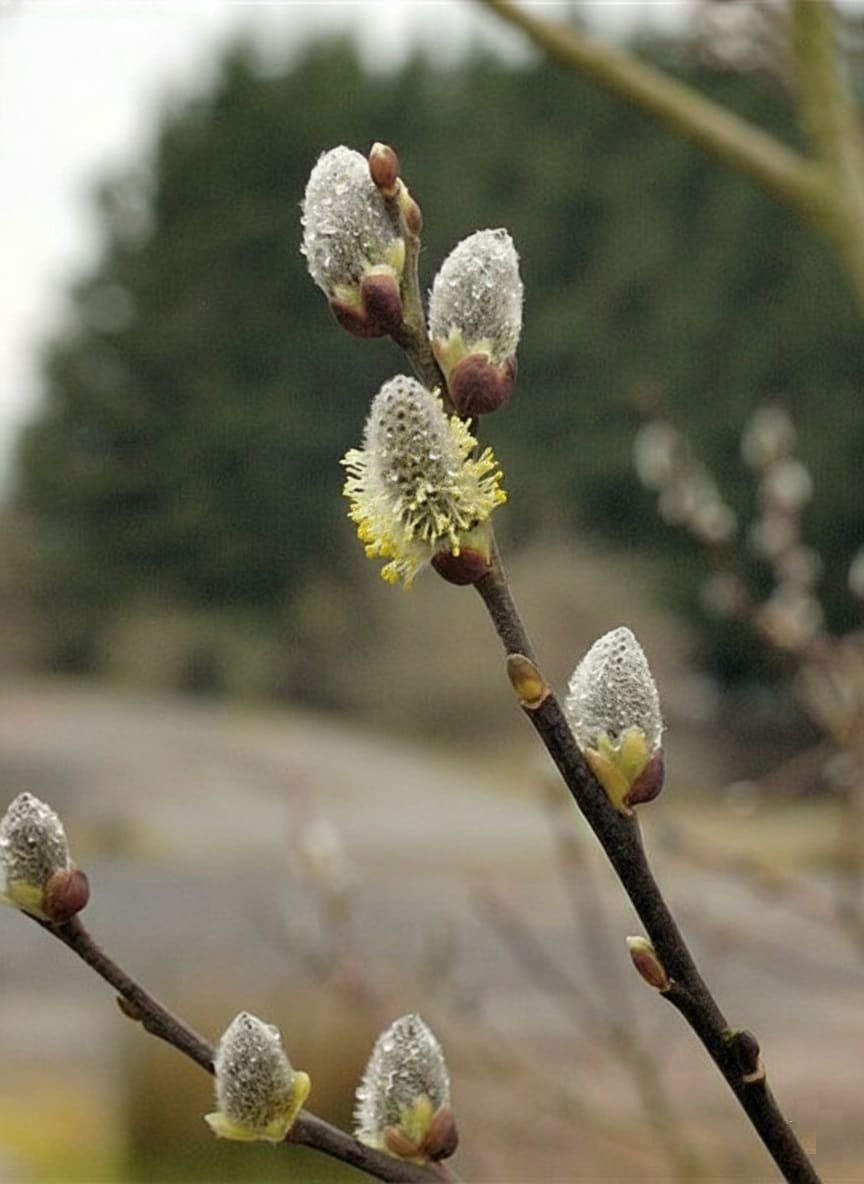
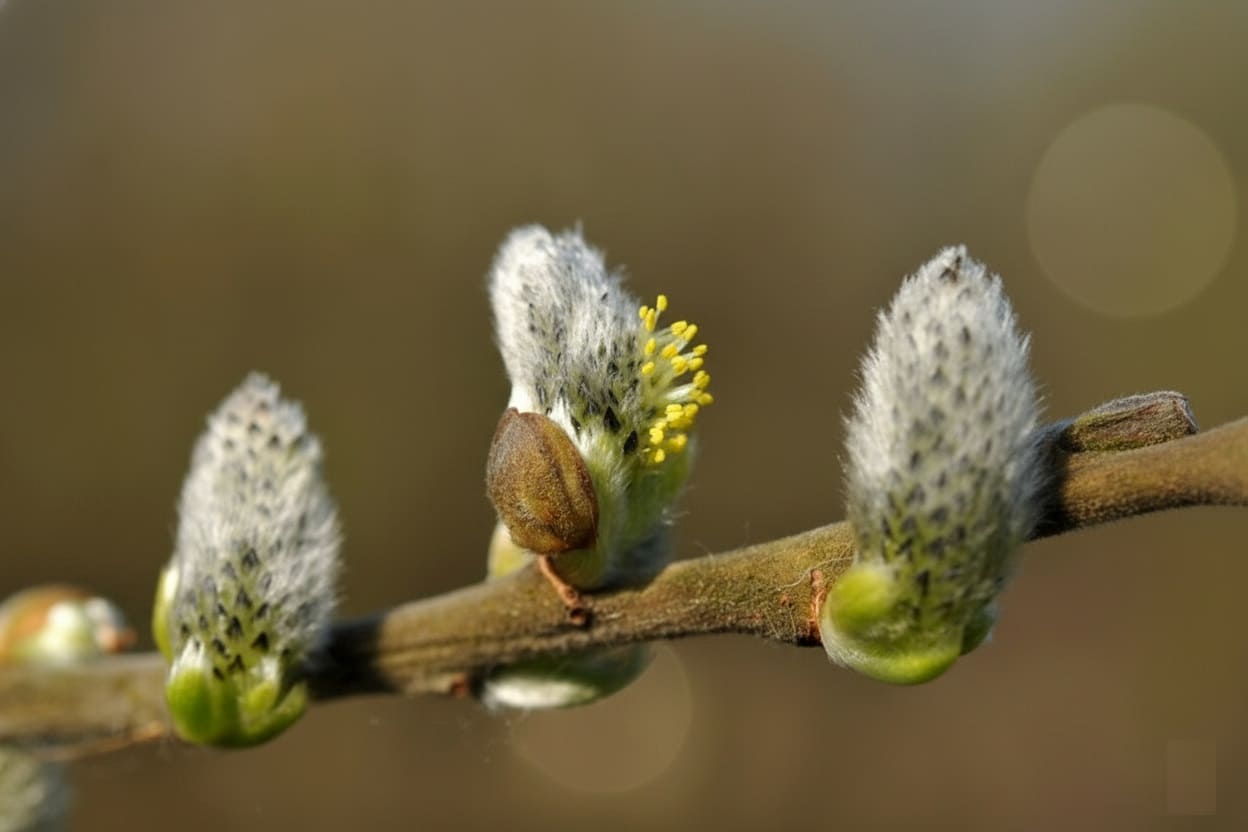

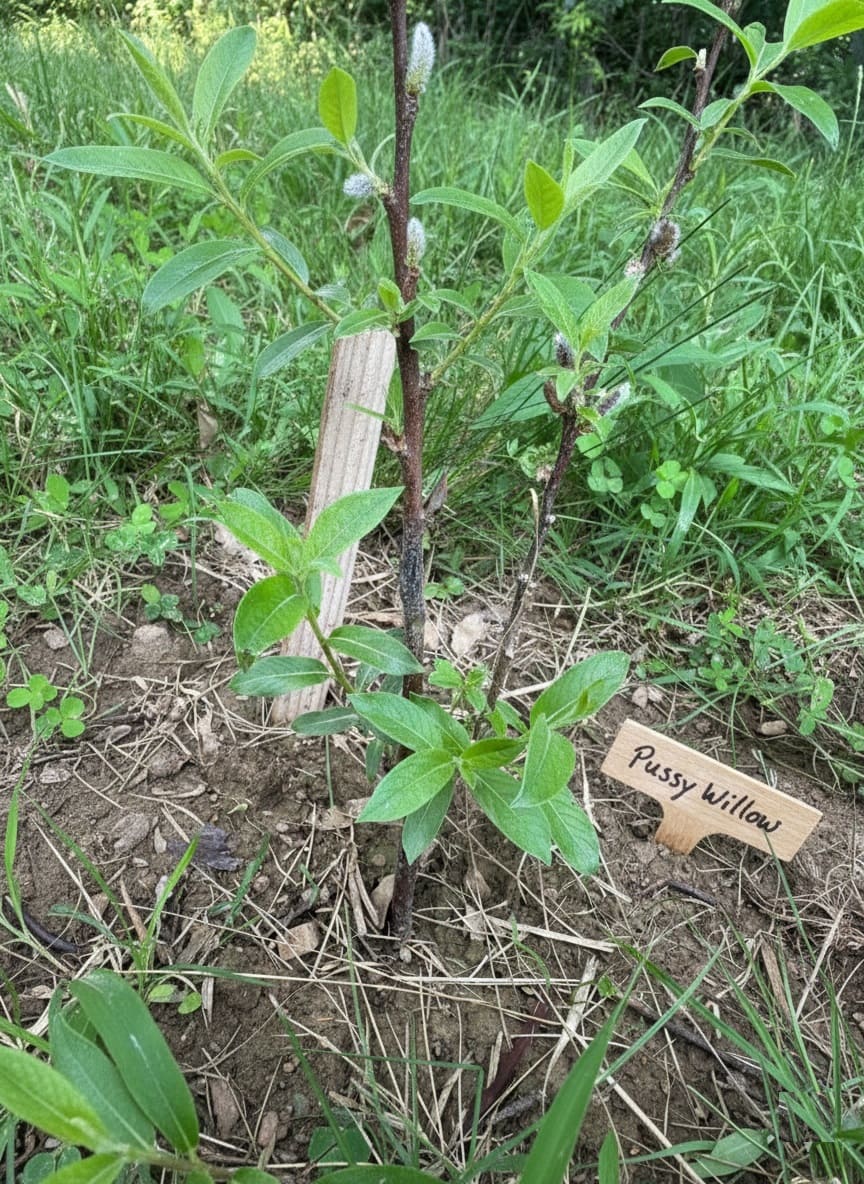



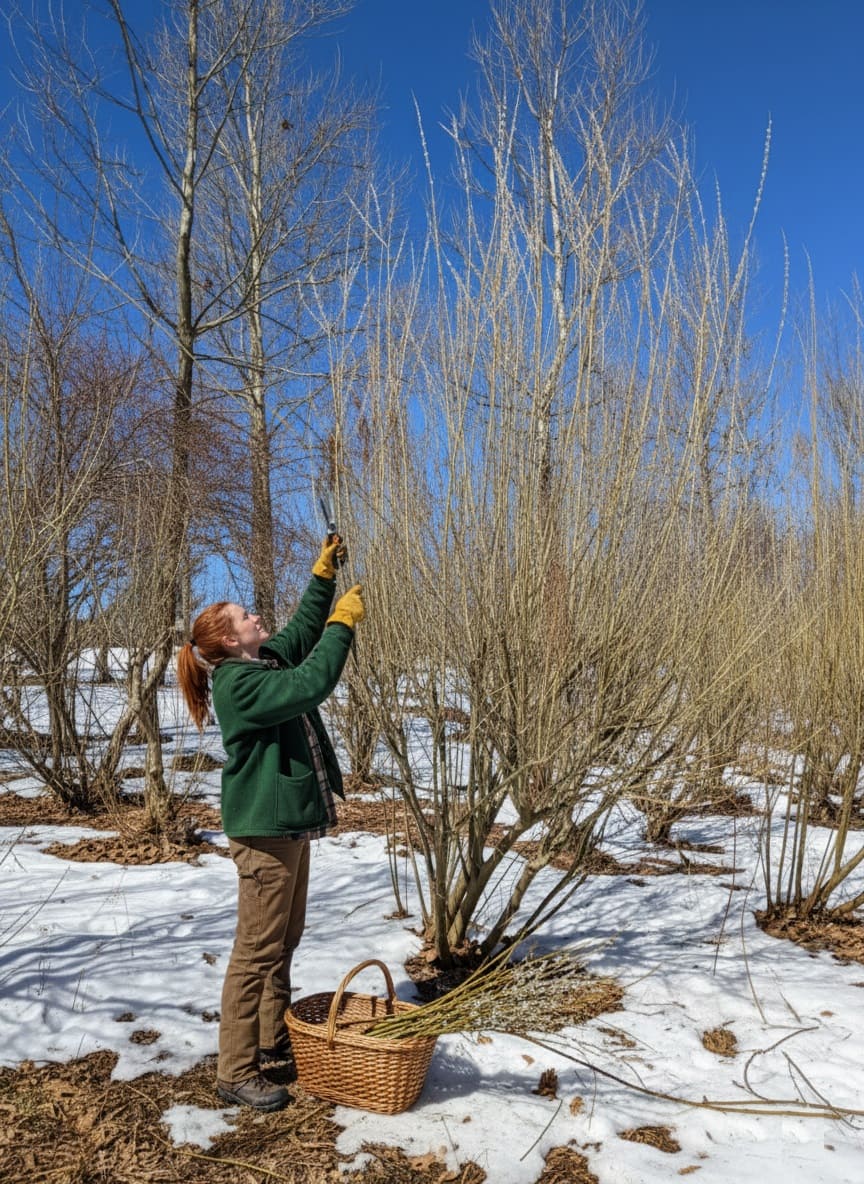



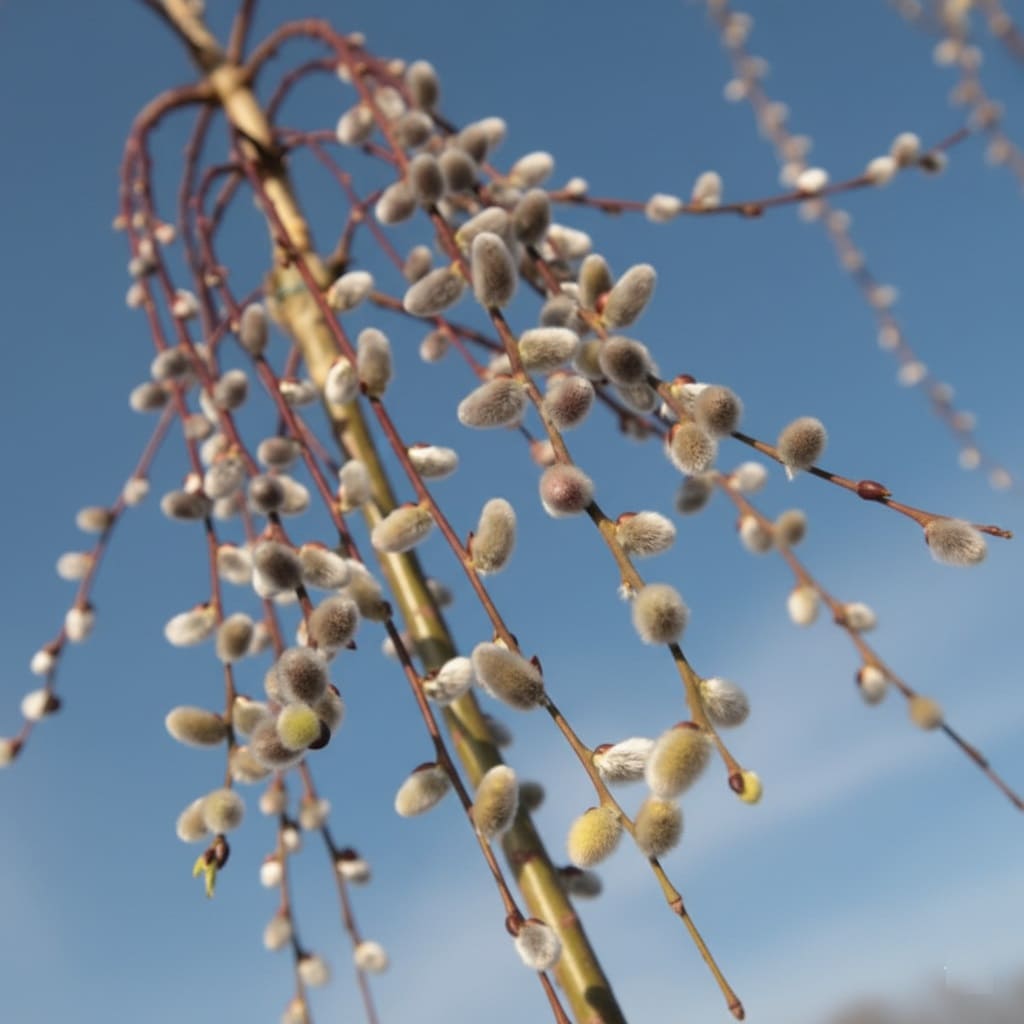
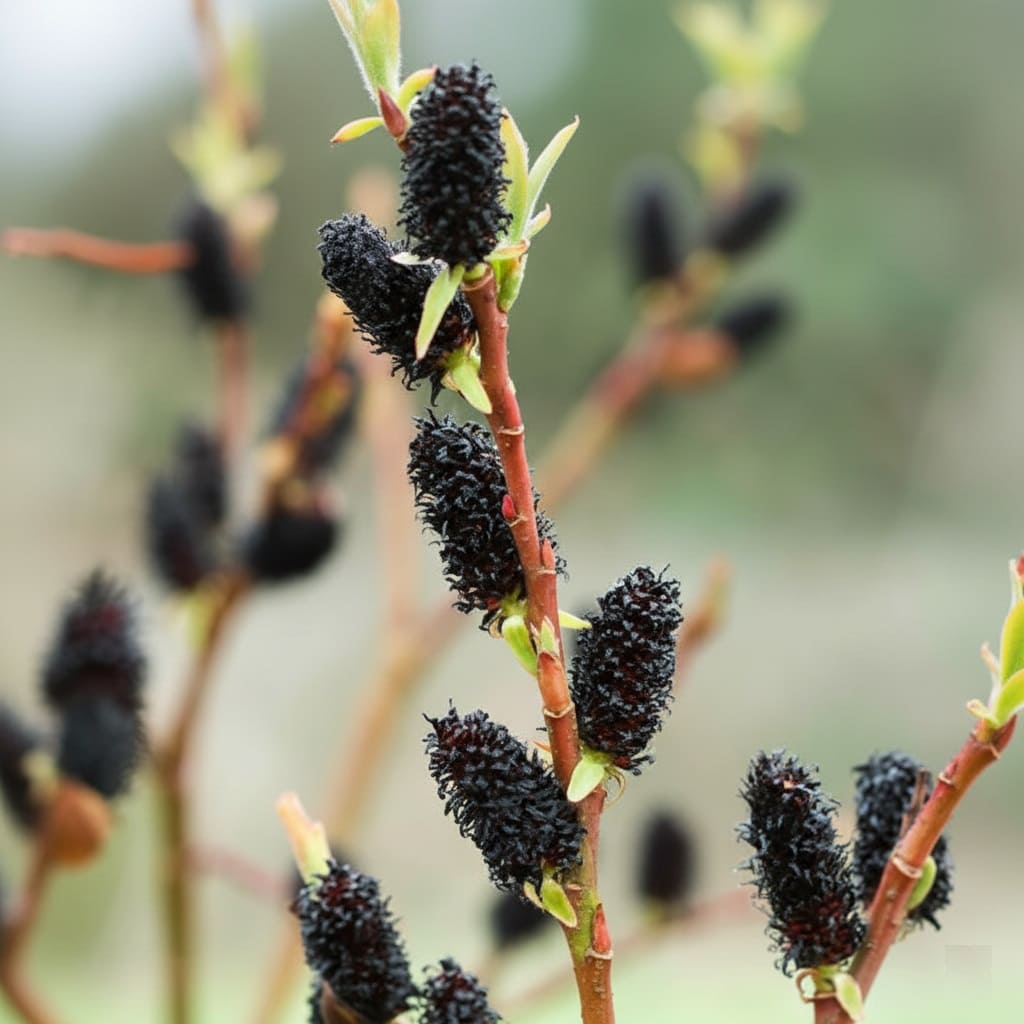
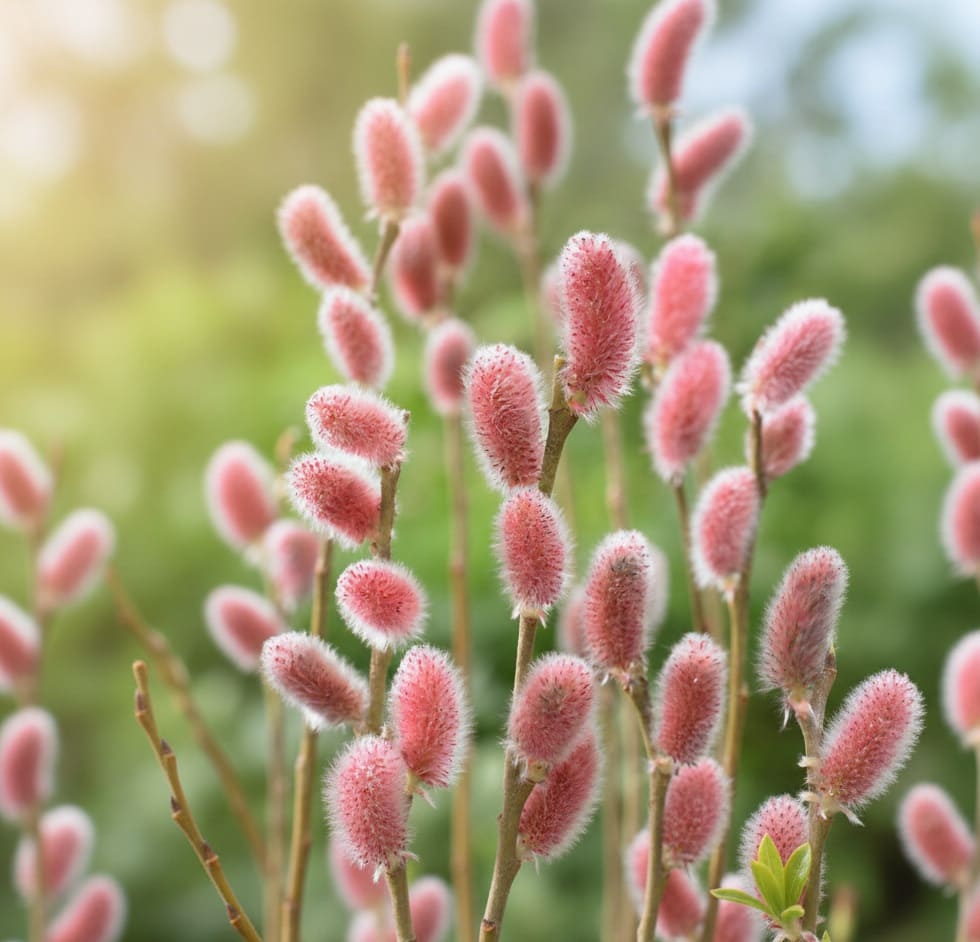
No comments:
Post a Comment